An online project under the direction of the CAPE ANN MUSEUM
inv. 248
"Sweepstakes"
Clipper Ship "Sweepstakes"
1853 Oil on canvas 26 x 48 1/4 in. (66 x 122.6 cm) Signed, inscribed, and dated lower right: Fitz Henry Lane. / Gloucester, Mass. / 1853.
|
Supplementary Images
Explore catalog entries by keywords view all keywords »
Historical Materials
Below is historical information related to the Lane work above. To see complete information on a subject on the Historical Materials page, click on the subject name (in bold and underlined).
New York City's large population and busy harbor meant that in the mid-nineteenth century it served as the largest domestic market for American products as well as the supplier for most of the export goods for the United States. In 1850 its population was larger than that of Philadelphia and nearly five times as large as that of Boston. (1)
The large broad harbor of New York, easily accessible from the Atlantic, encouraged foreign trade. But it also provided access to western New England and upstate New York via the Hudson River and southern New England via Long Island Sound. Between 1841-1850 New York handled an average of 60% of the U.S. imports and 30.5% of exports. (2) Piers, wharves, and docks ringed the south end of Manhattan: in 1850 over 60 on the East River served the foreign trade, while the 50 or more on the Hudson were filled with steamships and river boats to go up the river. (3) New York kept its position as the largest American seaport through its role as a market, a financial center, and its important position in the trade routes, but another advantage was its low wharfage rates. Although the wharves were notorious for their poor condition, in 1852 the cost to unload 1700 bales of cotton over two days in Boston or Baltimore was $68 while at a Hudson River pier it cost a mere $4.88. (4)
References:
See also: Robert Albion, The Rise of New York Port [1850-1871], David & Charles, 1971.
(1) Edward Spann, The New Metropolis: New York City 1840-1857, Columbia University Press, 1981, p.430.
(2) Spann p.436.
(3) Edwin G. Burrows and Mike Wallace, Gotham: A History of New York City to 1898, Oxford University Press, 1999, p.652.
(4) Burrows & Wallace, p.654
Color lithograph
Published by N. Currier, New York
LoC Catalog Number 90715981
Bird's-eye view of New York City with Battery Park in the foreground and Brooklyn Heights in the lower right corner.
Also filed under: Castle Garden »
Photograph
Johnson, H. and Lightfoot, F.S.: Maritime New York in Nineteenth-Century Photographs, Dover Publications, Inc., New York
The New York pilot boats would sail out to meet large incoming ships, flying the blue and white flag. The pilot would board the large ship and guide her into harbor. On outgoing trips the pilot boat would pick up the pilot after the ship in his charge had cleared the harbor.
Also filed under: Schooner (Pilot) »
15 1/2 x 13 1/2 in
New York Public Library
Barcode number 33333159142682
Also filed under: Tow Boat / Tug Boat »
Photograph
Johnson, H. and Lightfoot, F.S.: Maritime New York in Nineteenth-Century Photographs, Dover Publications, Inc., New York
Also filed under: Packet Shipping »
Survey of the Coast of the United States, New York Harbors, Washington, D.C.
Collection of Erik Ronnberg.
Also filed under: Maps »
Lithograph
Published by N. Currier, New York
Library of Congress Catalog Number 2002698126
Also filed under: Currier (& Ives) – New York »
Newspaper
Gloucester Telegraph, p. 2, col. 1
American Antiquarian Society
"F.H. Lane, Esq., with characteristic generosity has loaned some of his grand paintings to increase the interest of the occasion. A look at the Stiff Breeze in New York Harbor, one of the finest of his fine productions, and enough in itself to secure him enduring fame, is worth many times over the price of the admittance fee. A sailor could scarecely gaze upon the brig going in stays, without every moment expecting to hear the command given to 'let go and haul.'"
Also filed under: Gloucester Community / Participation / Other projects » // Newspaper / Journal Articles »
Telegraph and News
p. 2 column 2
"Fine Picture– Mr. F. H. Lane has placed in the Marine Insurance Office a very handsome picture of New York Harbor, which he has just completed. All sorts of vessels are represented in the foreground, with every particular rope in its proper place while in the background is the city with its forests of masts around the wharves it is truly a fine specimen of his artistic skill."
Also filed under: Gloucester, Mass. – Marine Insurance Company » // Newspaper / Journal Articles »
Oil on canvas
10 1/2 x 16 3/8 in.
Inscribed to Jenny Lind
New-York Historical Society, Purchase, Thomas Jefferson Bryan Fund (1977.76)
Also filed under: Castle Garden »
Lithograph
Published by N. Currier, New York
Also filed under: Currier (& Ives) – New York » // Tow Boat / Tug Boat » // Trinity Church »
Hand-colored lithograph
35 x 25 cm. on sheet 48 x 30 cm.
Published by Magnus & Co.
New York Public Library
Covers Manhattan up to 34th Street on the west side and 51st Street on the east side. Includes views of New York City and Harbor, and Trinity Church above the upper neat line. Also includes list of churches, hotels, and places of amusement.
Also filed under: Castle Garden » // Maps »
Oil on canvas
36 x 60 1/4 in.
Museum of Fine Arts, Boston, Gift of Maxim Karolik for the M. and M. Karolik Collection of American Paintings, 1815–65 (48.446)
Detail of Whitehall boat.
Also filed under: Whitehall Boat »
Lithograph
Published by N. Currier, New York
Library of Congress Catalog Number 2002698127
Also filed under: Currier (& Ives) – New York »
The clipper ship "Sweepstakes" was built in 1853 by Daniel and Aaron Westervelt of New York for Chambers and Heiser, N.Y.. She was the last and largest clipper ship built by the Westervelts. She went ashore in the Strait of Malacca and was condemned at Batavia in May 1862.
– Erik Ronnberg
In general, brigs were small to medium size merchant vessels, generally ranging between 80 and 120 feet in hull length. Their hull forms ranged from sharp-ended (for greater speed; see Brig "Antelope" in Boston Harbor, 1863 (inv. 43)) to “kettle-bottom” (a contemporary term for full-ended with wide hull bottom for maximum cargo capacity; see Ships in Ice off Ten Pound Island, Gloucester, 1850s (inv. 44) and Boston Harbor, c.1850 (inv. 48)). The former were widely used in the packet trade (coastwise or transoceanic); the latter were bulk-carriers designed for long passages on regular routes. (1) This rig was favored by Gloucester merchants in the Surinam Trade, which led to vessels so-rigged being referred to by recent historians as Surinam brigs (see Brig "Cadet" in Gloucester Harbor, late 1840s (inv. 13) and Gloucester Harbor at Dusk, c.1852 (inv. 563)). (2)
Brigs are two-masted square-rigged vessels which fall into three categories:
Full-rigged brigs—simply called brigs—were fully square-rigged on both masts. A sub-type—called a snow—had a trysail mast on the aft side of the lower main mast, on which the spanker, with its gaff and boom, was set. (3)
Brigantines were square-rigged on the fore mast, but set only square topsails on the main mast. This type was rarely seen in America in Lane’s time, but was still used for some naval vessels and European merchant vessels. The term is commonly misapplied to hermaphrodite brigs. (4)
Hermaphrodite brigs—more commonly called half-brigs by American seamen and merchants—were square-rigged only on the fore mast, the main mast being rigged with a spanker and a gaff-topsail. Staysails were often set between the fore and main masts, there being no gaff-rigged sail on the fore mast.
– Erik Ronnberg
References:
1. Howard I. Chapelle, The National Watercraft Collection (Washington, DC: Smithsonian Institution, 1960), 64–68.
2. Alfred Mansfield Brooks, Gloucester Recollected: A Familiar History (Gloucester, MA: Peter Smith, 1974), 62–74. A candid and witty view of Gloucester’s Surinam Trade, which employed brigs and barks.
3. R[ichard] H[enry] Dana, Jr., The Seaman's Friend (Boston: Thomas Groom & Co., 1841. 13th ed., 1873), 100 and Plate 4 and captions; and M.H. Parry, et al., Aak to Zumbra: A Dictionary of the World's Watercraft (Newport News, VA: The Mariners’ Museum, 2000), 95.
4. Parry, 95, see Definition 1.
Oil on canvas
17 1/4 x 25 3/4 in.
Cape Ann Museum, Gloucester, Mass., Gift of Isabel Babson Lane, 1946 (1147.a)
Photo: Cape Ann Museum
Detail of brig "Cadet."
Also filed under: "Cadet" (Brig) »
Painting on board
72 x 48 in.
Collection of Erik Ronnberg
Chart showing the voyage of the brig Cadet to Surinam and return, March 10–June 11, 1840.
Also filed under: "Cadet" (Brig) » // Surinam Trade »
Schooners in Lane’s time were, with few exceptions, two-masted vessels carrying a fore-and-aft rig having one or two jibs, a fore staysail, gaff-rigged fore- and main sails, and often fore- and main topsails. One variant was the topsail schooner, which set a square topsail on the fore topmast. The hulls of both types were basically similar, their rigs having been chosen for sailing close to the wind. This was an advantage in the coastal trade, where entering confined ports required sailing into the wind and frequent tacking. The square topsail proved useful on longer coastwise voyages, the topsail providing a steadier motion in offshore swells, reducing wear and tear on canvas from the slatting of the fore-and-aft sails. (1)
Schooners of the types portrayed by Lane varied in size from 70 to 100 feet on deck. Their weight was never determined, and the term “tonnage” was a figure derived from a formula which assigned an approximation of hull volume for purposes of imposing duties (port taxes) on cargoes and other official levies. (2)
Crews of smaller schooners numbered three or four men. Larger schooners might carry four to six if a lengthy voyage was planned. The relative simplicity of the rig made sail handling much easier than on a square-rigged vessel. Schooner captains often owned shares in their vessels, but most schooners were majority-owned by land-based firms or by individuals who had the time and business connections to manage the tasks of acquiring and distributing the goods to be carried. (3)
Many schooners were informally “classified” by the nature of their work or the cargoes they carried, the terminology coined by their owners, agents, and crews—even sometimes by casual bystanders. In Lane’s lifetime, the following terms were commonly used for the schooner types he portrayed:
Coasting schooners: This is the most general term, applied to any merchant schooner carrying cargo from one coastal port to another along the United States coast (see Bar Island and Mt. Desert Mountains from Somes Settlement, 1850 (inv. 401), right foreground). (4)
Packet schooners: Like packet sloops, these vessels carried passengers and various higher-value goods to and from specific ports on regular schedules. They were generally better-maintained and finished than schooners carrying bulk cargoes (see The Old Fort and Ten Pound Island, Gloucester, 1850s (inv. 30), center; and Gloucester Inner Harbor, 1850 (inv. 240), stern view). (5)
Lumber schooners: Built for the most common specialized trade of Lane’s time, they were fitted with bow ports for loading lumber in their holds (see View of Southwest Harbor, Maine: Entrance to Somes Sound, 1852 (inv. 260)) and carried large deck loads as well (Stage Rocks and the Western Shore of Gloucester Outer Harbor, 1857 (inv. 8), right). Lumber schooners intended for long coastal trips were often rigged with square topsails on their fore masts (see Becalmed Off Halfway Rock, 1860 (inv. 344), left; Maverick House, 1835 (not published); and Lumber Schooner in a Gale, 1863 (inv. 552)). (6)
Schooners in other specialized trades. Some coasting schooners built for carrying varied cargoes would be used for, or converted to, special trades. This was true in the stone trade where stone schooners (like stone sloops) would be adapted for carrying stone from quarries to a coastal destination. A Lane depiction of a stone schooner is yet to be found. Marsh hay was a priority cargo for gundalows operating around salt marshes, and it is likely that some coasting schooners made a specialty of transporting this necessity for horses to urban ports which relied heavily on horses for transportation needs. Lane depicted at least two examples of hay schooners (see Gloucester Harbor, 1850s (inv. 391), left; and Coasting Schooner off Boon Island, c.1850 (inv. 564)), their decks neatly piled high with bales of hay, well secured with rope and tarpaulins.
– Erik Ronnberg
References:
1. Howard I. Chapelle, The History of American Sailing Ships (New York: W.W. Norton & Co., 1935), 258. While three-masted schooners were in use in Lane’s time, none have appeared in his surviving work; and Charles S. Morgan, “New England Coasting Schooners”, The American Neptune 23, no. 1 (DATE): 5–9, from an article which deals mostly with later and larger schooner types.
2. John Lyman, “Register Tonnage and its Measurement”, The American Neptune V, nos. 3–4 (DATE). American tonnage laws in force in Lane’s lifetime are discussed in no. 3, pp. 226–27 and no. 4, p. 322.
3. Ship Registers of the District of Gloucester, Massachusetts, 1789–1875 (Salem, MA: The Essex Institute, 1944). Vessels whose shipping or fishing voyages included visits to foreign ports were required to register with the Federal Customs agent at their home port. While the vessel’s trade or work was unrecorded, their owners and master were listed, in addition to registry dimensions and place where built. Records kept by the National Archives can be consulted for information on specific voyages and ports visited.
4. Howard I. Chapelle, The National Watercraft Collection (Washington, DC: Smithsonian Institution, 1960), 40, 42–43.
5. Ibid., 42–43, 73.
6. Ibid., 74–76.
A topsail schooner has no tops at her foremast, and is fore-and-aft rigged at her mainmast. She differs from an hermaphrodite brig in that she is not properly square-rigged at her foremast, having no top, and carrying a fore-and-aft foresail instead of a square foresail and a spencer.
Wood rails, metal rollers, chain; wood cradle. Scale: ½" = 1' (1:24)
Original diorama components made, 1892; replacements made, 1993.
Cape Ann Museum, from Gloucester Chamber of Commerce, 1925 (2014.071)
A schooner is shown hauled out on a cradle which travels over racks of rollers on a wood and metal track.
Also filed under: Burnham Brothers Marine Railway » // Marine Railways »
Glass plate negative
Collection of Erik Ronnberg
Also filed under: Lobstering »
Details about Maine's lumber trade in 1855, see pp. 250–52
Also filed under: Castine » // Lumber Industry »
The term "ship," as used by nineteenth-century merchants and seamen, referred to a large three-masted sailing vessel which was square-rigged on all three masts. (1) In that same period, sailing warships of the largest classes were also called ships, or more formally, ships of the line, their size qualifying them to engage the enemy in a line of battle. (2) In the second half of the nineteenth century, as sailing vessels were replaced by engine-powered vessels, the term ship was applied to any large vessel, regardless of propulsion or use. (3)
Ships were often further defined by their specialized uses or modifications, clipper ships and packet ships being the most noted examples. Built for speed, clipper ships were employed in carrying high-value or perishable goods over long distances. (4) Lane painted formal portraits of clipper ships for their owners, as well as generic examples for his port paintings. (5)
Packet ships were designed for carrying capacity which required some sacrifice in speed while still being able to make scheduled passages within a reasonable time frame between regular destinations. In the packet trade with European ports, mail, passengers, and bulk cargos such as cotton, textiles, and farm produce made the eastward passages. Mail, passengers (usually in much larger numbers), and finished wares were the usual cargos for return trips. (6) Lane depicted these vessels in portraits for their owners, and in his port scenes of Boston and New York Harbors.
Ships in specific trades were often identified by their cargos: salt ships which brought salt to Gloucester for curing dried fish; tea clippers in the China Trade; coffee ships in the West Indies and South American trades, and cotton ships bringing cotton to mills in New England or to European ports. Some trades were identified by the special destination of a ship’s regular voyages; hence Gloucester vessels in the trade with Surinam were identified as Surinam ships (or barks, or brigs, depending on their rigs). In Lane’s Gloucester Harbor scenes, there are likely (though not identifiable) examples of Surinam ships, but only the ship "California" in his depiction of the Burnham marine railway in Gloucester (see Three Master on the Gloucester Railways, 1857 (inv. 29)) is so identified. (7)
– Erik Ronnberg
References:
1. R[ichard)] H[enry] Dana, Jr., The Seaman’s Friend, 13th ed. (Boston: Thomas Groom & Co., 1873), p. 121 and Plate IV with captions.
2. A Naval Encyclopaedia (Philadelphia: L. R. Hamersly & Co., 1884), 739, 741.
3. M.H. Parry, et al., Aak to Zumbra: A Dictionary of the World’s Watercraft (Newport News, VA: The Mariners’ Museum, 2000), 536.
4. Howard I. Chapelle, The History of American Sailing Ships (New York: W.W. Norton & Co., 1935), 281–87.
5. Ibid.
6. Howard I. Chapelle, The National Watercraft Collection (Washington, DC: Smithsonian Institution, 1960), 26–30.
7. Alfred Mansfield Brooks, Gloucester Recollected: A Familiar History (Gloucester, MA: Peter Smith, 1974), 67–69.
Photograph
From American Clipper Ships 1833–1858, by Octavius T. Howe and Frederick C. Matthews, vol. 1 (Salem, MA: Marine Research Society, 1926).
Photo caption reads: "'Golden State' 1363 tons, built at New York, in 1852. From a photograph showing her in dock at Quebec in 1884."
Also filed under: "Golden State" (Clipper Ship) »
Oil on canvas
24 x 35 in.
Peabody Essex Museum, Salem, Mass.
Walters' painting depicts the "Nonantum" homeward bound for Boston from Liverpool in 1842. The paddle-steamer is one of the four Clyde-built Britannia-class vessels, of which one is visible crossing in the opposite direction.
View related Fitz Henry Lane catalog entries (2) »
Also filed under: Packet Shipping » // Walters, Samuel »
"Engine-powered vessel" is a collective term used by nautical historians to include all vessel types using engine power of any type for propulsion, whether assisted by sails, oars, or other motive power. In Lane's time, steam reciprocating engines fueled by wood or coal were the only practical source of this power for ships using paddle-wheels or screw propellers to convert heat energy into motion.
For most of the nineteenth century, steamships had sails for auxiliary power; indeed the earliest examples relied principally on sails, using engine power in calm weather to shorten the voyage time or keep to a schedule. As engines became more efficient, powerful, and reliable, sail plans were reduced, to be used only to steady a vessel's motion in a seaway (for the sake of seasick passengers), or to maintain headway if the engine broke down. Only harbor craft, ferry boats, and coastwise passenger steamers relied solely on engine power.
Among Lane's depictions of steamships, the auxiliary steam packet Auxiliary Steam Packet Ship Massachusetts (inv. 442) is a good example of primary reliance on sails, while the steam demi-bark The "Britannia" Entering Boston Harbor, 1848 (inv. 49) and the Cunard Liner "Britannia", 1842 (inv. 259) have relegated sails to secondary (or simply emergency) motive power.
– Erik Ronnberg
Castine Historical Society Collections (2015.03)
Also filed under: Historic Photographs » // Steamers »
Published by James French, Boston
Volume 1848-49
Boston Public Library
Call number 39999059856813
See p. 30 of directory.
Also filed under: "Britannia" (Cunard Steamship) » // "Caledonia" (Cunard Steamship) » // Trade Routes and Statistics »
Cartoon
9 1/4 x 13 3/4 in (23.495 x 34.925 cm)
Peabody Essex Museum, Salem, Mass.
Jonny and a Yankee:
Jonny: "Ho my Hi! 'ow she goes!! it his'nt fair I ham sure t'aint!!! She must 'av an engine hunder the keel..."
Yankee: "Where are your yachts now, Jonny? s-a-y- Do you think your wash tubs can come up to a real Yankee Clipper? Sorry for you, Jonny, but it can't be helped... A Yankee Ship a Yankee Crew, you know Jonny."
Also filed under: "America" (Schooner Yacht) »
Lithograph
Library of Congress Catalog Number 2002706878
Design of side wheel steamer showing wheel mechanism, side view and cross-section in ten figures. This design proved a failure in the few vessels that employed it. The paddle wheel enclosures filled with water, causing resistance which greatly impaired efficiency and increased fuel consumption.
– Erik Ronnberg
Oil on canvas
Maine Maritime Museum
Also filed under: Castine »
Steamer schedules for 1855, including the schedule for the steamer, "T. F. Secor" which served Castine, see pp. 234–35.
Also filed under: "T. F. Secor" (Steamboat) » // Castine » // Publications » // Steamers »
The ensign of the United States refers to the flag of the United States when used as a maritime flag to indentify nationality. As required on entering port, a vessel would fly her own ensign at the stern, but a conventional token of respect to the host country would be to fly the flag of the host country (the United States in Boston Harbor, for example) at the foremast. See The "Britannia" Entering Boston Harbor, 1848 (inv. 49) for an example of a ship doing this. The American ensign often had the stars in the canton arranged in a circle with one large star in the center; an alternative on merchant ensigns was star-shaped constellation. In times of distress a ship would fly the ensign upside down, as can be seen in Wreck of the Roma, 1846 (inv. 250).
The use of flags on vessels is different from the use of flags on land. The importance and history of the flagpole in Fresh Water Cove in Gloucester is still being studied.
The modern meaning of the flag was forged in December 1860, when Major Robert Anderson moved the U.S. garrison from Fort Moultrie to Fort Sumter in Charleston Harbor. Adam Goodheart argues this was the opening move of the American Civil War, and the flag was used throughout northern states to symbolize American nationalism and rejection of secessionism.
Before that day, the flag had served mostly as a military ensign or a convenient marking of American territory, flown from forts, embassies, and ships, and displayed on special occasions like American Independence day. But in the weeks after Major Anderson's surprising stand, it became something different. Suddenly the Stars and Stripes flew—as it does today, and especially as it did after the September 11 attacks in 2001—from houses, from storefronts, from churches; above the village greens and college quads. For the first time American flags were mass-produced rather than individually stitched and even so, manufacturers could not keep up with demand. As the long winter of 1861 turned into spring, that old flag meant something new. The abstraction of the Union cause was transfigured into a physical thing: strips of cloth that millions of people would fight for, and many thousands die for.
– Adam Goodheart, Prologue of 1861: The Civil War Awakening (2011).
Stereograph card
Cape Ann Museum Library & Archive
A view of a Cove on the western side of Gloucester Harbor, with the landing at Brookbank. Houses are seen in the woods back. A boat with two men is in the foreground.
Also filed under: Brookbank » // Fresh Water Cove » // Historic Photographs »
Courtesy American Antiquarian Society, Worcester, Mass. (CL.F9116.011.1854 CL.F9116.011.1854)
Also filed under: Oak Hall »
Courtesy American Antiquarian Society, Worcester, Mass. (CL.F9116.011.1854)
Also filed under: Oak Hall »
The use of signal flags, for ship-to-ship communication, generally preceded land-based chains of maritime semaphore stations, the latter using flags or rotating arms, until the advent of the electric or magnetic telegraph.
Until the end of the Napoleonic wars, merchant ships generally sailed in convoy as ordered by the escorting warship(s) using a few simple flags. Peace brought independent voyaging, the end of the convoy system, and the realization by various authorities that merchant vessels now needed their own separate means of signaling to each other. This resulted in a handful of rival codes, each with its individual flags and syntax. In general, they each had a section enabling ship identification and also a "vocabulary" section for transmitting selected messages. It was not until 1857 that a common Commercial Code became available for international use, only gradually replacing the earlier ones. All existed side by side for a decade or two.
Signal systems for American ships were originally intended to identify a vessel by name and owner; only later were more advanced systems developed to convey messages. Most basic were private signals, or "house flags", each of a different design or pattern, identifying the vessel's owner; identification charts were local and poorly distributed, limiting their usefulness. A secondary signal, a flag or large pennant bearing the vessel's name, was sometimes flown by larger ships, but pictorial records of them are uncommon. These private signal flags usually flew from the foremasthead or main masthead if a three master ship. Pilot boats had their own identifying flags, blue and white as seen in Spitfire Entering Boston Harbor (inv. 536). Small vessels, such as schooners, often had a "tell-tale" pennant, an often-unmarked and often red flag, that was used to determine wind direction.
A numerical code flag system, identifying vessels by the code numbers, was introduced by Captain Frederick Marryat R.N. in 1817 for English vessels. American vessels soon adopted this system. Elford's "marine telegraphic system" was the first American equivalent to the Marryat code flags, first issued in 1823, and with changes, remaining in use until the late 1850s. Most of the signal flags on vessels depicted by Lane use Elford's; Brig "Antelope" in Boston Harbor, 1863 (inv. 43) is a noteworthy example of his depiction of Marryat's. The Elford's Code was popular in America on account of its simplicity and only required six blue and white flags. Eventually these changed to red and white, although it is unclear exactly when this happened. Instructions and a key ot the Elford's Code's use are included in successive editions of the Boston Harbor Signal Book.
Whereas the other codes employ at least ten flags of diverse shapes and colours, there are only six Elford flags in total, representing the numbers one to six. All are uniformly rectangular and monochrome in colour (either blue and white or red and white—or even black and white as in an early photograph). Selected from these six flags each individual vessel is allotted a combination of four flags to be prominently displayed as a vertical hoist. Reading from above down these convey its "designated number." Armed with this number and the type of vessel (e.g. ship, bark, brig, schooner /or steamer) the subject can be uniquely identified by reference to a copy of the Boston Harbor Signal Book for the appropriate year.
– A. Sam Davidson
As reproduced in Yankee Sailing Ship Cards by Allan Forbes and Ralph M. Eastman (Boston: State Street Trust Company, 1948).
Also filed under: "Eastern Star" (Bark) » // Forbes, Robert Bennet »
Harvard Depository: Widener (NAV 578.57)
For digitized version, click here.
Also filed under: Boston Harbor »
Boston: Eastburn's Press
New York Public Library
Complete book is included in Google Books, click here.
In The American Neptune 3, no. 3 (July 1943): 205–21.
Peabody Essex Museum
Descriptions of Marryat, Elford, Rogers, and commercial code signal systems, and private signals. Includes illustrations of flag systems with color keys.
Lane usually signed his works, "F.H.L." or "F.H.Lane." Only two paintings are known to have his complete signature. His use of initials in his signature led to the confusion about his middle name. For a complete discussion of this see Sarah Dunlap and Stephanie Buck's article on his name change.
Newsprint
Boston Evening Transcript
"Old Clipper Ships: Wanted – Paintings of old Clipper Ships. Paintings by Fitz Hugh Lane Preferred. Address D.A.W. Boston Transcript."
Also filed under: Newspaper / Journal Articles »
MSS .S300
no date
includes Lane's signature as member, and lists him as "Painter, Gloucester" on p. 32
Also filed under: Boston – Boston Artists Association » // Documents / Objects »
MSS .S300
p.32
no date
Also filed under: Boston – Boston Artists Association » // Documents / Objects »
Oil on canvas
28 x 48 1/2 in.
Cape Ann Museum, Gloucester, Mass., Deposited by the City of Gloucester, Given to the city by Mrs. Julian James in memory of her grandfather Sidney Mason, 1952 (DEP. 200)
Detail of Lane's signature. The image has been color enhanced for legibility.
Letter
Terra Foundation for American Art, Chicago
A letter affixed to the verso of Lane's Dream Painting of 1862 in which he describes how the idea for the painting came to him in a dream. Lane writes: "This picture, the Property of John S. Webber Esq, Collector of the Port and District of Gloucester, was (suggested) to the artist by a dream. Sometime last fall while asleep in bed, a richly furnished room was presented to my imagination. Upon the wall my attention was attracted to a picture which I have here endeavored to reproduce. The dream was very vivid and on awakening I retained it in memory for a long time. The effect was so beautiful in the dream that I determined to attempt its reproduction, and this picture is the result. The drawing is very correct, but the effect falls far short of what I saw, and it would be impossible to convey to canvas such gorgeous and brilliant colouring as was presented to me. This picture, however, will give to the beholder some faint idea of the ideal. /signed/ Fitz H. Lane."
Also filed under: Chronology » // Davidson, Dr. Herman Elvas » // Letters » // Letters / Manuscripts » // Webber, John Somes »
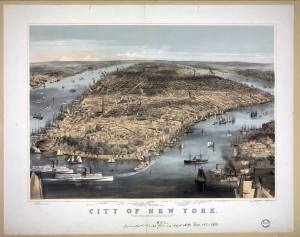
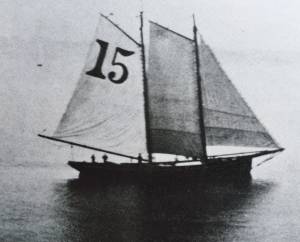
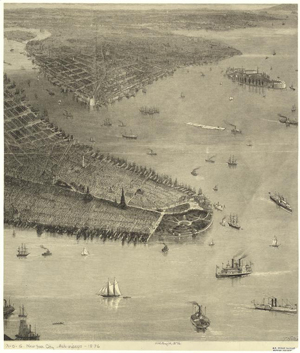
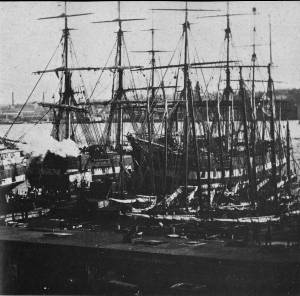

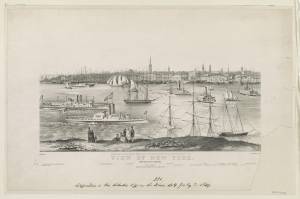
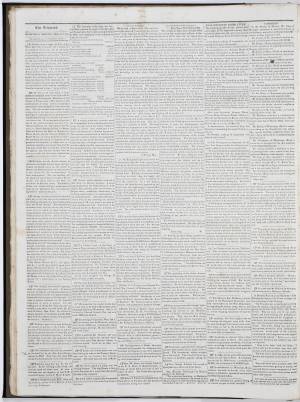
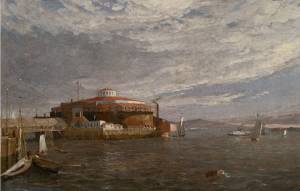
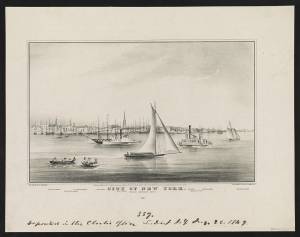


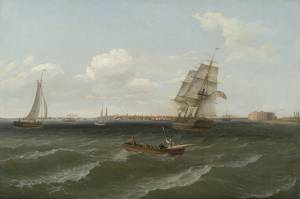
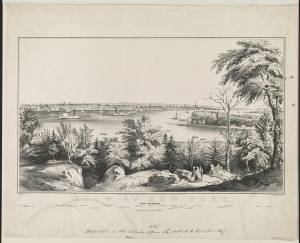
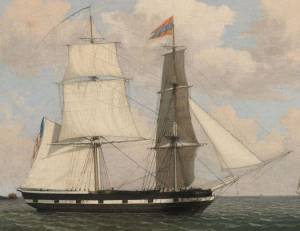

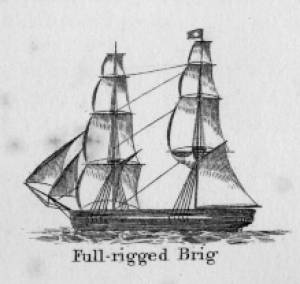

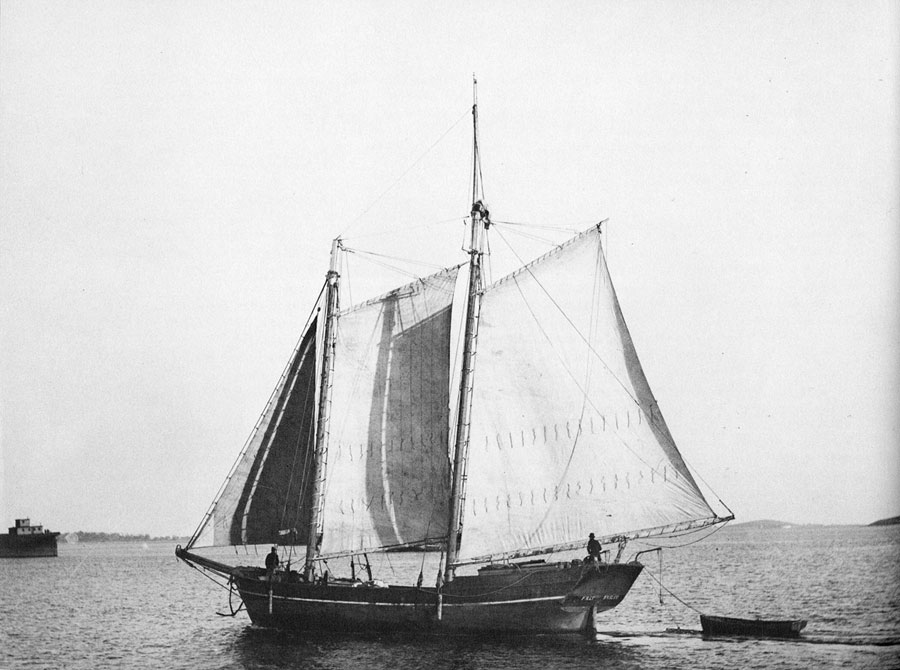
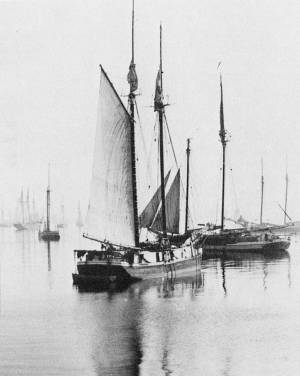


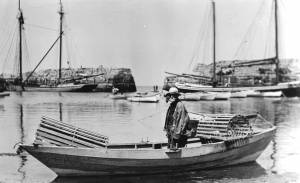

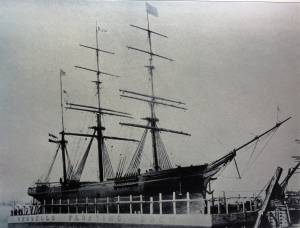
_sm.jpg)

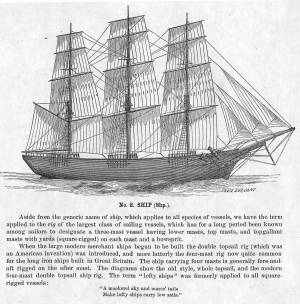
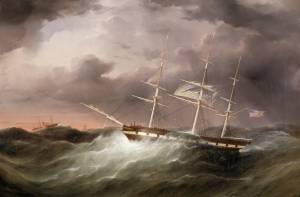

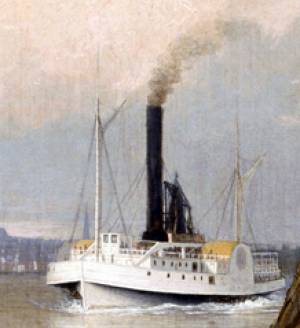

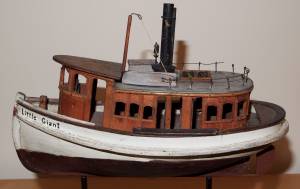

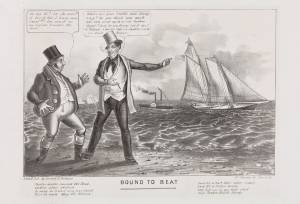

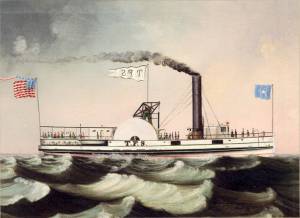
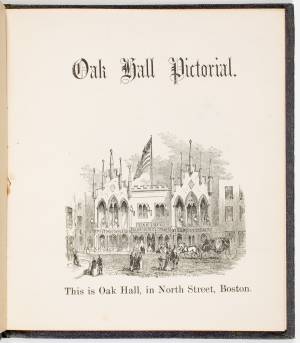
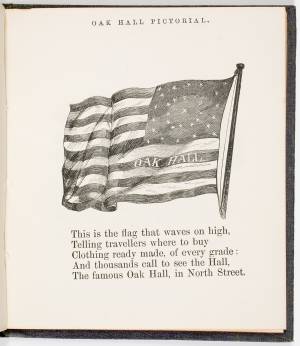





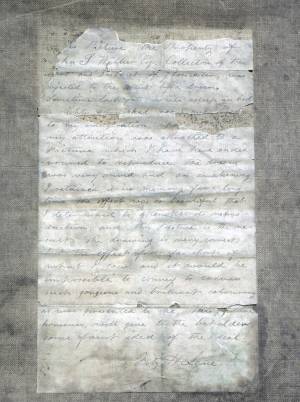
Commentary
This very fine ship portrait of 1853 has helped to rectify the one-hundred-year-old misnomer of the artist Fitz Henry Lane as Fitz "Hugh" Lane. After Lane’s death in 1865, his work had fallen out of favor as European and romantic tastes became fashionable. He was all but forgotten until some of his work was included in a show of marine art mounted by the India House, a private club in lower New York City that was founded in 1914—nearly fifty years after Lane's death. As biographers have noted, there are multiple references in the early twentieth century to Fitz "Hugh" Lane. By the 1940s, all further scholarship referenced these earlier sources.
The painting is signed in the lower right corner: "Fitz Henry Lane, Gloucester, Mass. 1853." (See below.) This is one of only two known works signed "Fitz Henry Lane." Interestingly, the other is also a New York ship portrait from 1854, The "Golden State" Entering New York Harbor, 1854 (inv. 238). "Golden State" was a clipper ship with the same ownership, Chambers and Heiser, and they presumably commissioned both paintings.
Perhaps Lane wanted to be sure his full name and address were known in New York. This was the largest and most important art market, and he was just breaking into it. He typically signed his paintings "F.H. Lane" or "Fitz H. Lane" and was certainly well known by those abbreviated initials in Boston and Gloucester.
All we know about the clipper ship "Sweepstakes" is that she was built in 1853 by Daniel and Aaron Westervelt of New York for Chambers and Heiser of New York. She was the last and largest clipper ship built by the Westervelts. She went ashore in the Strait of Malacca and was condemned at Batavia in May 1862.
This is quite a large ship's portrait, fully four feet wide, and shows all of Lane’s mastery of the genre. The ship is shown hove-to in a typical profile, but Lane has covered only half the canvas with her. In the right half he shows a full-rigged ship, possibly a naval vessel, heading away on a diagonal, giving depth to the composition. A hermaphrodite brig angling towards the clipper adds additional interest. In the foreground is a square-sterned yawl boat with a man standing in the stern who is clearly hailing the "Sweepstakes."
The location is unknown, but it may well be in the broad bay at the mouth of New York harbor. It is a blustery day with scudding clouds and a frothy chop in the very green water. The ship is flying a blue-and-white swallowtail pennant with a red tail—the house flag of Chambers and Heiser—on its foremast. An American flag flies off its stern gaff.
– Sam Holdsworth
[+] See More